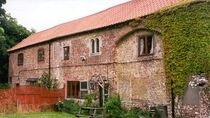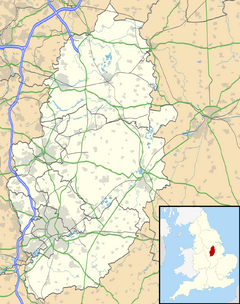| Main | Births etc |
|---|

St Wilfrid's, Scrooby
| Scrooby | |
| District | Bassetlaw |
|---|---|
| Shire county | Nottinghamshire |
| Region | East Midlands |
| Country | England |
| Sovereign state | United Kingdom |
| Post town | DONCASTER |
| Postcode district | DN10 |
| Dialling code | 01302 |
| Police | Nottinghamshire |
| Fire | Nottinghamshire |
| Ambulance | East Midlands |
| EU Parliament | East Midlands |
| UK Parliament | Bassetlaw |
| List of places: UK • England • Nottinghamshire | |
Scrooby is a small village, on the River Ryton and near Bawtry, in the northern part of the English county of Nottinghamshire. At the time of the 2001 census it had a population of 329.[1] Until 1766, it was on the Great North Road so became a stopping-off point for numerous important figures including Queen Elizabeth I and Cardinal Wolsey on their journeys. The latter stayed at the Manor House briefly, after his fall from favour.
History[]
1604 Scrooby Separaists[]

Scrooby Separatists were a mixed congregation of early English Protestants / non-conformists founding living in the border region of of South Yorkshire, Lincolnshire and Nottinghamshire. They were called "Separatists" because of their rebellion against the religious authority of the Church of England, the official state religion. In 1607/8 the Congregation emigrated to Netherlands in search of the freedom to worship as they chose. Shortly after that they were the basis of the group to sail in the Mayflower to the New World.
The Manor House belonged to the Archbishops of York and at the end of the sixteenth century, was occupied by William Brewster (1527-1590), the Archbishop's bailiff, who was also postmaster. His son, William Brewster (1567-1644), took that post in the 1590s after a job as an assistant to the Secretary of State under Queen Elizabeth I. The junior William became dissatisfied with the Anglican Church as it was developing at the time, acquired Brownist beliefs and attempted to leave for the Netherlands in 1607. After an unsuccessful first attempt, Brewster succeeded in 1608. He eventually went to New England in 1620 on the Mayflower, as one of the people later called Pilgrim Fathers. The Manor House was demolished early in the 19th century. All that remain are a cottage (perhaps intended for a resident official and not open to the public), a substantial brick dovecote and the fishponds.
1779 Gibbet Hill Murders[]

Gibbet Hill Lane refers to the grim events of 1779
Just north of Scrooby, the road that links the A638 and the A614 is called Gibbet Hill Lane. This lane is so named after a brutal crime that took place early in the morning of 3 July 1779 when John Spencer, who had been playing cards with Scrooby's toll-bar keeper, William Yeadon, and his mother (then on a visit), returned to the toll house and killed both of them. The crime was enacted for the purposes of robbery, and Spencer gained re-admittance under a pretence that a drove of cattle wished to pass that way. Spencer was interrupted by travellers in the act of dragging one body across the road towards the River Ryton, and arrested shortly thereafter by a search party.[2] He was executed following a trial at Nottingham Assizes, and his body afterwards hung in a gibbet cage on a slope south of the Ryton now denominated Gibbet Hill. The reputed upright of the gibbet is preserved in Doncaster Museum [3]
Landmarks[]
St Wilfrids Church[]

Scrooby village circa 1911
The parish church of St Wilfrid has an octagonal spire.[4] Other buildings of interest are the remaining buildings on the site of the former manor house, the mill, the old vicarage, the village's historic farmhouses, and the pinfold. The village stocks were sold to America, more than a hundred years ago.
Notable People[]
- William Brewster (1567-1644) - A lay leader who held Separatists church meetings at his home. His manor house has been identified as on the site of the old Scrooby Palace of the archbishops of York, though much of the older building had been demolished by then. His family sailed on the Mayflower
- John Dunham (1589-1669) - pilgrim separatist from Scrooby, moved to Holland and then in 1629 to Plymouth.
References[]
- ^ "Area:Scrooby CP (Parish"
- ^ White Francis & Co (1864). History, Gazetteer, and Directory of the County, and of the Town and County of the Town of Nottingham.p.693
- ^ Codd, Daniel (2013). Tales from the Gibbet Post (Scrooby's Toll-booth Murders). Amazon Media EU S.à r.l. Kindle Edition. ASIN: B00D2B8OWA
- ^ Pevsner, Nikolaus. 1979. The Buildings of England:Nottinghamshire.Harmondsworth, Middx. Penguin.
External links[]
| ||||||||||||||
| This page uses content from the English language Wikipedia. The original content was at Scrooby. The list of authors can be seen in the page history. As with this Familypedia wiki, the content of Wikipedia is available under the Creative Commons License. |

